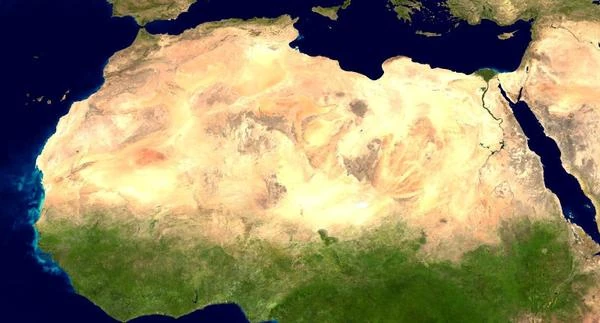
The Sahara is today the largest hot desert on the planet, but its history is marked by intense climatic and hydrological cycles. Its formation results from a combination of geological, tectonic, and climatic factors spanning several million years.
Note: The word Sahara comes from the Arabic as-sahraʾ, which literally means "the desert" or "the vast expanse of sand." This term reflects the Arab-Muslim vision of North Africa as a region dominated by arid and desert landscapes. It refers not only to the dunes but to the entire desert ecosystem, including rocky plateaus, regs, oases, and temporary basins.
The geological structures of the Sahara, including sedimentary basins, peripheral mountain ranges, and stabilized plateaus, testify to long processes: erosion, fluvio-lacustrine deposition, tectonic uplifts, and crustal movements. The formation of dunes and the accumulation of aeolian sediments mainly date back to the Pleistocene, about 2.5 million to 10,000 years ago.
During the Quaternary (2.58 million years ago to present), the North African climate was strongly influenced by orbital cycles (precession, obliquity, eccentricity) that modified the seasonal distribution of insolation. These variations caused alternations between humid periods, with lakes and dense vegetation, and arid periods similar to the current Sahara. The humid periods, known as "African Humid Periods," correspond to phases when the African monsoon reached the central Sahara.
The main African Humid Period, about 11,500 to 5,500 years ago, allowed the existence of temporary rivers, lakes, and extensive vegetation. Isotopic, sedimentological, and paleoecological analyses show that the Sahara was then a semi-arid to sub-humid environment, favoring the settlement of human populations and animals. The progressive desertification around 4,000 years before our era corresponds to a decline in precipitation and the establishment of the current arid climate.
| Period | Event or Phase | Comment |
|---|---|---|
| Miocene – Pliocene (23-2.6 Ma) | Marine and lacustrine deposits | Formation of basins and pre-desert sediments |
| Pleistocene (2.5 Ma – 10 ka) | Gradual establishment of dunes | Aeolian accumulation linked to glacial and interglacial cycles |
| Middle Quaternary | Alternating humid periods | Activation of lakes and temporary vegetation, orbital control of insolation |
| Holocene (11.5 – 5.5 ka) | African Humid Period | Expansion of rivers and lakes, strong human occupation |
| Around 4 ka | Final desertification | Current arid climate, retreat of vegetation and lakes |
The Sahara, the world's largest hot desert, is at the heart of major environmental challenges. Climate warming is accelerating desertification and threatening fragile ecosystems. However, initiatives are emerging to combat these phenomena:
The Sahara holds natural resources and economic opportunities that are still under-exploited:
Technological advances could transform the Sahara into an innovation hub:
The stability of the Sahara depends on regional and international cooperation:
The Sahara is also a space of cultural and historical diversity:
By 2050, the Sahara could become:
| Period | Country / Region | Project / Event | Comment |
|---|---|---|---|
| 2023–2025 | Western Sahara / Dakhla | Dakhla Atlantic deep-water port | Port capable of accommodating container ships and supertankers, aiming to open up Sahel countries and promote South-South trade. Part of the Moroccan Atlantic Initiative. |
| 2023–2025 | Western Sahara / Dakhla | Seawater desalination plant | Meets drinking water needs and supports agricultural and tourist development in the region. |
| 2023–2025 | North Africa / Central Sahara | Desertec project (solar energy) | Potential export of solar electricity to Europe and development of green hydrogen. Work continues despite security and governance challenges. |
| 2025 | Morocco / Dakhla-Oued Eddahab | Renewable energies and agriculture | Multiplication of projects in the solar, wind, agriculture, and tourism sectors, creating local jobs and attracting foreign investment. |
| 2024–2026 | Algeria / Southern Sahara | Hassi R’Mel photovoltaic solar park | Major project for green electricity, aiming to supply cities and reduce dependence on hydrocarbons. |
| 2023–2027 | Mali / Timbuktu and Saharan region | Management and valorization of groundwater | Mapping of fossil aquifers and installation of boreholes for sustainable agriculture and drinking water supply. |
| 2023–2026 | Tunisia / Southern Sahara | Sustainable tourism and ecotourism | Creation of protected areas and tourist circuits to develop the local economy while preserving desert ecosystems. |
| 2024–2025 | Egypt / Western Desert | Mining exploration and phosphate extraction | Projects for the exploitation of mineral deposits, integrating sustainability practices and limiting environmental impact. |